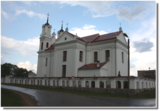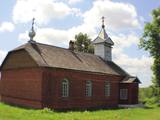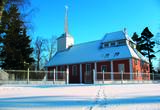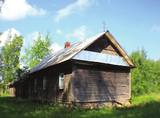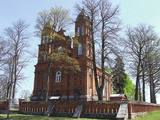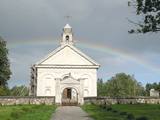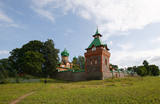| Nr | Name | Beschreibung |
|---|---|---|
|
Construction of the church began in 1830 thanks to money donated by nobleman Ludvigs Šabanskis. The Baroque stone church is surrounded by a restored stone fence, and inside there are icons including "Heart of Jesus," "Christ's Suffering," and "St Joseph." The church is not open to the public on a daily basis. |
||
|
Die Kirche befindet sich im Zentrum der kleinenOrtschaft Dviete. Die weiße Gestalt der Kirche ist schon von weitem zu sehen. Die erste Kirche aus Holz wurde hier im Jahr 1775 unter der Leitung des Landgutbesitzers J. K. Wischling gebaut. Später wurde das Gotteshaus abgerissen und in den Friedhof von Zarinki versetzt. Die heutige Gestalt (im Stil Neobarock, mit zwei Türmen) hat die katholische Kirche von Dviete im Jahr 1864 dank der Finanzierung des Grafen Kasimir Plater-Sieberg bekommen. Die Kirche wurde im Ersten Weltkrieg zerstört, darum wurde bis zu ihrem Wiederaufbau und ihrer Einweihung im Jahr 1929 als der Gebetsraum die Kornkammer des Landgutes von Dviete (mit einem Giebeldach) verwendet, die sich am Rand der Straße Dviete – Bebrene befindet und heute erneuert ist. Im Jahr 1940 wurde um die Kirche ein gemauerter Zaun mit einem Ziegeldach, aber in den 1970er Jahren – das Gemeindehaus gebaut. Das Gotteshaus hat eine besonders prachtvolle barocke Innenausstattung, die als die prachtvollste in dem ehemaligen Bezirk von Daugavpils betrachtet wird. |
||
|
Atrodas t.s. Baznīcu kalnā – 18. novembra ielā 66. Apjoma ziņā – lielākais Daugavpils luterāņu dievnams, kuru cēla laikā no 1891. - 1893. g. neogotiskā stilā no sarkanajiem ķieģeļiem (arhitekts Vilhelms Neimanis). 1941. g. baznīcā izcēlās ugunsgrēks un gāja bojā lielākā daļa no tās sākotnējās iekārtas. Turpmāko divu gadu laikā baznīcu daļēji atjaunoja, taču vēlāk tajā izveidoja noliktavu u.c. baznīcai „nepiederīgas” iestādes. 1985. g. ēka vēlreiz cieta ugunsgrēkā. Pagājušā gadsimta deviņdesmito gadu sākumā uzsāka baznīcas atjaunošanas darbus, uzstādīja solus un altāri, kas ir Ogres Amatniecības vidusskolas audzēkņu darinājums. |
||
|
Found in the northern part of Cesvaine, the church was built of fieldstones in the Neo-Gothic style in 1879 by the architect Paul Max Bertschy. The church was restored in 1929 and again in the early 1990s. The altar painting, “Christ on the Cross” (1923) is by Jēkabs Bīne.
|
||
|
according to legend, was washed into the sea because of collapsing shores along with other buildings and the old road. The church was built in 1862 and has an altar painting from the late 19th century, "Mother of God," along with an organ. The metal elements of the building's doors are interesting. Hanging from the ceiling of the church is a sailing ship that has to do with the rescue of the crew of the sunken ship. |
||
|
Puderova Old-Believers Prayer House. The architectural monument of local importance was built in
the beginning of the 20th century.
|
||
|
Wenn man am nördlichen Ufer des Sees von Sauka (wo die Kreuzung nach Klauce ist) fährt, kann man die von Bäumen umsäumte evangelisch-lutherische Kirche von Sauka sehen. Das heutige Gebäude ist das dritte Gotteshaus an dieser Stelle. Es wurde im Jahr 1827 eröffnet und es ist hauptsächlich von außen zu besichtigen. Der Altar der Kirche ist mit den Skulpturen der Apostel Peter und Paul und mit dem Altargemälde von Julius Döring Christus am Kreuz mit Maria und Johannes geschmückt. Die Orgel haben Meister aus Jelgava, aber die Pfeifen – Meister aus Sauka hergestellt. |
||
|
Die erste Kirche in Piņķi war aus Holz. Eine Idee über den Bau einer neuen Kirche erschien schon in den 50er Jahren des 19. Jahrhunderts, aber der erste Baustein wurde am 25. Mai 1872 gelegt (Architekt J. D. Felsko). Die Kirche ist von 1872 bis 1874 gebaut worden. Eine Orgel mit neun Registern wurde vom bekannten Orgelmeister Wilhelm Sauer 1890 gebaut. Am 17. Juli 1916 hatte hier das 5. Bataillon der Lettischen Schützen, das zur Frontlinie marschierte, nahe dem Landgut von Piņķi Unterkunft bezogen. An dem erwähnten Tag hat der Oberst Jukums Vācietis in der Kirche in Piņķi eine Predigt gehalten (über diesen Fakt haben Historiker verschiedene Meinungen), die zu einem der bedeutendsten Ereignissen der Geschichte Lettlands jener Zeit wurde. Das historische Ereignis hat den lettischen Dichter und Schriftsteller Aleksandrs Čaks dazu veranlassen, das in seinem Gedicht “Predigt in der Kirche in Piņķi” zu verewigen. Die Kirche (Kulturdenkmal) kann man auch von innen betrachten. In der dunklen Tageszeit wird das Gebäude angestrahlt. Nahe der Kirche befindet sich ein Gedenkstein für die Lettischen Schützen. |
||
|
Bоrisovas St. Nikolay Old-Believers Prayer House was built in the period of 1911 – 1921 . The different feature of the Prayer House is a brick building placed on the hill. The bell of the temple was specially
ordered and brought from St. Petersburg. The bell has a very soft sound.
|
||
|
Roman Catholic Church of Divine Grace – On 19 April 1998, the so-called “White Sunday” or the Day of Divine Grace, Saulkrasti Roman Catholic Church of Divine Grace was consecrated. The building is 24 m long and its tower is 16 m high. The 300-seat church was designed by the architect Jānis Šrēders. The image of Christ on the altarpiece was derived from the vision of the saint, Sister Faustina, of 22 February 1931 in a monastery in Poland. The altarpiece was created by the artist Ēriks Pudzēns. 14 paintings on the walls of the church depict Christ’s path of suffering from conviction to resurrection. The altar is built of ash. On 2 August 1998, a 7.38 m tall cross was consecrated by Saulkrasti Roman Catholic Church of Divine Grace. At night this cross is illuminated. The cross is similar to the cross of Golgotha in Jerusalem where Jesus Christ was crucified. |
||
|
Befindet sich am höchsten mit Bäumen bewachsenen Ufer des Flusses Marki hinter der Grenzkontrollstelle von Piedruja. Zur Kirche führt eine Straße aus Pflastersteinen, die wahrscheinlich die einheimischen Bauer am Anfang des 20. Jahrhunderts gelegt haben. Es war eine Pflicht, ein Stein mitzunehmen, wenn man zum Gottesdienst geht. Dieser Stein wurde später für den Straßenbelag verwendet. Diese Kirche mit sechs Kuppeln ist eine der schönsten im heutigen Bezirk Krāslava. Die Kirche ist von 1883 bis 1885 an der Stelle der alten Holzkirche gemäß den architektonischen Formen der altrussischen Stadt Wladimir und bisantischen architektonischen Formen (17. Jahrhundert) gebaut worden. Es gibt Informationen, dass die Größe der Gemeinde ehemals sogar eine Tausend Gemeindemitglieder erreichte. |
||
|
Paramonovas Old-Believer Preaching House was built in
1882.
|
||
|
Es gibt eine Erzählung über einen dänischen Händler, der sich bei einem Schiffbruch am Kap von Kolka gerettet und als Dank in Kolka eine Kirche gebaut hat. In Kolka hat es mehrere Kirchen gegeben, die ihren Standort gewechselt haben. Das Fundament des heutigen aus Feldsteinen gebauten Gotteshauses hat der damalige Inhaber des Landgutes von Dundaga Karl Ludwig Ferdinand von der Osten-Sacken gelegt. Das Gotteshaus ist an der Stelle (oder in der Nähe) der hölzernen Kirche gebaut, die sehr stark im Krimkrieg gelitten hatte. Die ersten Bauarbeiten wurden von dem Baumeister Oto Zīverts im Jahr 1885 (Architekt Teodors Zeilers) angefangen. Während der Sowjetzeit wurde die Kirche gewaltsam ausgeraubt und in dem Gebäude wurde ein Lagerraum eingerichtet. Es ist wert, das moderne Altargemälde (Künstlerin Helēna Heinrihsone) zu besichtigen, dem kein anderes Altargemälde in keiner anderen Kirche ähnlich ist. Früher befand sich an der Stelle des Gemäldes ein Kreuz. |
||
|
Sts. Simon and Judas the Apostles Roman Catholic Church of
Prezma. The brick stone church with its two towers was built in 1859.
The Monument of National significance.
|
||
|
Divine Providence Catholic Church of Rikava (Baltini) was built in Doric style in 1929 by the donations
of landlord Alexander Riks. The church has icons „St. Antony” and „Jesus Christ appears to Mary
Magdalene”. Beside the church there is a cemetery and family vault of Riks.
|
||
|
Das Gotteshaus ist im Jahr 1895 gebaut, aber im Jahr 1906 umgebaut worden. Auf seinem Turm befinden sich drei Glocken, die aus Silber und Kupfer gegossen sind und von denen eine zu der größten Glocke (4832 kg) in den baltischen Staaten ernannt worden ist. Neben dem Gottsehaus befindet sich ein Museum, das mit der Kultur und dem Kirchenleben der Altgläubigen bekannt macht. Dieser Ort ist einer der seltenen Orte der Altgläubigen, der öffentlich zugänglich ist. |
||
|
One of the most unusual houses of worship in the national park, this one has a red brick tower, and together with local residential buildings it makes up an interesting cultural landscape. The prayer house is not open to the public. |
||
|
Im nördlichen Teil des Parks von Zasa befindet sich die im Jahr 1750 gebaute und nicht große evangelisch-lutherische Kirche von Zasa. Heute ist die Orgel des Gotteshauses erneuert worden, die der bekannte Orgelbaumeister Andrejs Sūnākslis gebaut hat. An der Kirche befindet sich der Friedhof der im Ersten Weltkrieg gefallenen deutschen Soldaten. |
||
|
Die Kirche hat einen 1800 gebauten einzigartigen achteckigen Glockenturm. Blick auf den Lūšiai-See. |
||
|
Kloster von Kuremäe wurde im Jahr 1891 errichtet und es ist das einzige tätige russisch-orthodoxe Nonnenkloster in Estland. In den vergangenen Tagen befand sich hier der Hainort der altertümlichen Esten. Am Berg ist eine Opferquelle, die heute wegen seines heilenden Wassers als heilige Quelle genannt wird. Kloster ist für die Touristen geöffnet und alltägliches Leben der Klosterbewohner kann man besichtigen. Wer den ganzen Klosterkomplex besichtigen möchte, kann von Nonnen eine Führung bestellen. |
||

